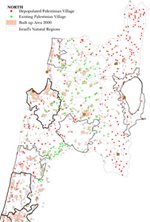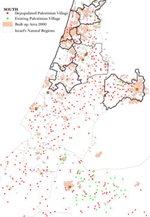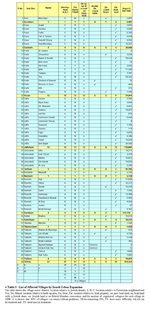Another Israeli claim is that all village traces are lost and have been built over by housing for new immigrants. Again, even if this were true, it would not undermine the Right of Return: robbery of a property does not grant a title deed to the robber. However, the claim is false. We have enough records, maps, documents and registers, thanks to the British Mandate, sufficient to retrace every dunum. This information is available to Israel; on its basis it distributes Palestinian property to new immigrants. In Fig-10 and Fig-11, all the existing built-up areas in Israel today have been
-
 Fig-10: Built-up Area in Israel North (2000): The Location of the present built-up area shows that over 90% of the sites of Palestinian villages remain vacant.
Fig-10: Built-up Area in Israel North (2000): The Location of the present built-up area shows that over 90% of the sites of Palestinian villages remain vacant.
Thick black lines define high Jewish density 'natural regions'. Medium lines indicate medium Jewish density and light lines indicate low Jewish density.
-
 Fig-11: Built-up Area in Israel South (2000): The Location of the present built-up area shows that over 90% of the sites of Palestinian villages are vacant.
Fig-11: Built-up Area in Israel South (2000): The Location of the present built-up area shows that over 90% of the sites of Palestinian villages are vacant.
The areas around Jerusalem and Tel Aviv require special treatment.
plotted. Superimposed on them are the sites of 531 towns and villages depopulated by the Israelis in 1948. The striking result is that the sites of the absolute majority of such villages are still vacant. All village sites, except one each in the sub districts of Safad, Acre, Tiberias and Nazareth, are vacant. Naturally, the area most affected is the coastal strip, especially in the Tel Aviv suburbs. There, a dozen village sites have been built over as a result of the expansion of the city. The displaced refugees from these built-over areas now number 110,000, or only 3 percent of all registered refugees. The largest depopulated villages are Salama, Yazur, and Beit Dajan, with a combined population of 75,000. A number of village sites west of Jerusalem, and north and south of Tel Aviv, have been also built over.
However, well over 90 percent of the village refugees could return to empty sites. Of the small number of affected village sites, 75 percent are located on land totally owned by Arabs and 25 percent on Palestinian land in which Jews have a share. Most affected villages are small. Only 27 percent of the villages affected by new Israeli construction have a present population of more than 10,000. The rest are much smaller. See Section-12.5 and Table-3 for futrher discussion.

The accommodation of the returning refugees from the affected villages is fairly simple, at least from an operational point of view: they could retain the property rights and grant a term lease to existing occupants, most of which are institutions. Meanwhile, they could rent or build housing for themselves in the vicinity. We are, however, left with the comfortable prospect that the overwhelming majority of the refugees would be able to return to currently empty sites. Their re-housing should not be an insurmountable problem, as will be shown in Section-12.6.